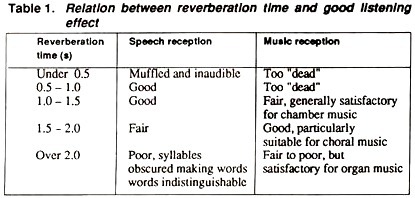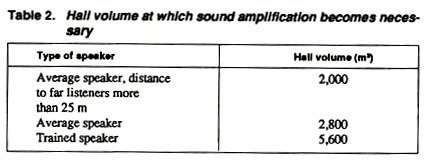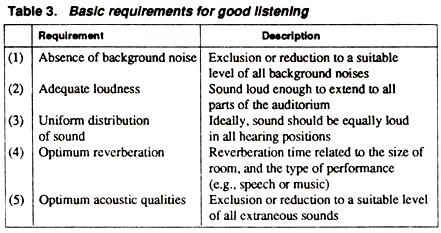After reading this article you will learn about :- 1. Reverberation Time of an Auditorium 2. Speech in an Auditorium 3. Control of Acoustics.
Reverberation Time of an Auditorium:
Reverberation time T of a room can be calculated using the formula
T = kV/A, …(1)
where T = reverberation time (in seconds), V = volume of the enclosure (in m3), A = Total absorption (in sabines), and k = a constant (= 1.796 in the SI system of units).
A range of optimum reverberation times can be broadly defined for rooms on the basis of their volumes and intended uses. A general relationship between reverberation time and good listening effect is shown in Table 1.
A fuller or richer quality of sound is obtained in an auditorium where the reverberation time for lower frequencies is greater than that for the middle and higher frequencies. This difference in quality is, however, more generally noticeable with music rather than speech.
On the other hand, variable sound absorption characteristics, resulting in reverberation times varying with frequency, can interfere with speech to such extent that there can be excessive absorption of consonant or vowel sounds. Thus it is desirable, for general speech quality, that the absorption coefficients of the finishes used in acoustic treatment of auditoria should be as uniform as possible over the frequency range 200-7,000 Hz.
Speech in an Auditorium:
Subtleties of speech are provided by the quality known as “presence or “intimacy”. This quality is gained, as a general rule, by the reinforcement of direct sound with reflected waves, with a very short initial time delay (of the order of 5 milliseconds).
In an auditorium, account must also be taken of the directional characteristics of typical speech. It is known, for example, that higher frequency sound levels off rapidly outside an angle of about 140° subtended symmetrically at the position of the speaker. The seats for the audience, therefore, should ideally be laid out in a pattern falling within this sector.
Speech levels achieved in an auditorium will be dependent on the reverberation time as well as the shape and volume of the room. The speech levels may be further enhanced by the provision of suitable reflective surfaces, where appropriate. Ideally, the paths of direct sound waves should be as short as possible in order to reduce the losses of sound energy in the air.
This consideration favours a compact shape of an auditorium with:
(a) A low volume per seat,
(b) A raised platform for the speaker, and
(c) The elimination of any physical obstructions between the speaker and listeners.
The last condition may be provided by raked seats and the absence of columns inside the auditorium. In the case of larger halls, even with favourable room acoustics, the speech level may still be too low for satisfactory listening.
When this is the case, a sound amplification system can be installed to achieve a high degree of speech intelligibility. Recommendations in this respect are, however, influenced by the type of auditorium covered and the normal background noise levels.
As a general rule, a sound amplification system becomes desirable for high intelligibility of speech if the volume of the hall exceeds about 1,400 m3 and the background noise level is likely to exceed 40 dB. If the background noise level is appreciably higher than 40 dB, sound amplification may be required even with smaller volumes.
This is particularly the case when the content of background noise covers frequencies in the normal speech range, the acoustic properties of the hall are relatively poor, or the walls are treated with sound-absorbing materials.
For acoustically well-designed auditoria with no intrusive noise, on the other hand, considerably larger halls may prove suitable without resort to sound amplification systems. Some specific recommendations in this respect, based on the room volume, are given in Table 2. Apart from an overall increase in sound levels, sound amplification is also be useful for other purposes.
Control of Acoustics in an Auditorium:
It is quite possible to provide flexible acoustics in an auditorium with the help of large-scale versatility in the building fabric, e.g., swiveling and height- adjustable acoustic panels. The cost of this, however, becomes prohibitive as the size of the hall increases. It is more common, therefore, to design an auditorium specifically for either speech or music.
The basic requirements for good listening are given in Table 3. Among these criteria, the absence of background noise and optimum reverberation time can be controlled directly by means of sound absorption treatment, and the last requirement, viz., optimum acoustic qualities, can be largely controlled by such treatment.
In usual practice, the background noise level is rigidly controlled with the help of sound insulation applied to all surfaces of the enclosure, as required. In this respect, the suppression of noise from ventilating ducts may be particularly important. It may be necessary to hold down background noise levels to 40 dB, or less, over all frequencies within the audible frequency range.


